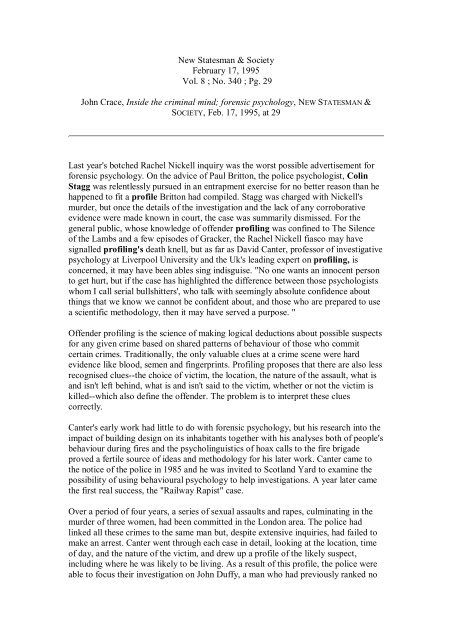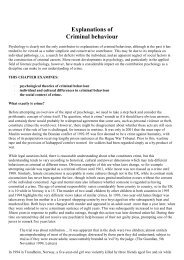David Canter - forensic psychologist - Jeff Standen
David Canter - forensic psychologist - Jeff Standen
David Canter - forensic psychologist - Jeff Standen
You also want an ePaper? Increase the reach of your titles
YUMPU automatically turns print PDFs into web optimized ePapers that Google loves.
New Statesman & Society<br />
February 17, 1995<br />
Vol. 8 ; No. 340 ; Pg. 29<br />
John Crace, Inside the criminal mind; <strong>forensic</strong> psychology, NEW STATESMAN &<br />
SOCIETY, Feb. 17, 1995, at 29<br />
Last year's botched Rachel Nickell inquiry was the worst possible advertisement for<br />
<strong>forensic</strong> psychology. On the advice of Paul Britton, the police <strong>psychologist</strong>, Colin<br />
Stagg was relentlessly pursued in an entrapment exercise for no better reason than he<br />
happened to fit a profile Britton had compiled. Stagg was charged with Nickell's<br />
murder, but once the details of the investigation and the lack of any corroborative<br />
evidence were made known in court, the case was summarily dismissed. For the<br />
general public, whose knowledge of offender profiling was confined to The Silence<br />
of the Lambs and a few episodes of Gracker, the Rachel Nickell fiasco may have<br />
signalled profiling's death knell, but as far as <strong>David</strong> <strong>Canter</strong>, professor of investigative<br />
psychology at Liverpool University and the Uk's leading expert on profiling, is<br />
concerned, it may have been ables sing indisguise. "No one wants an innocent person<br />
to get hurt, but if the case has highlighted the difference between those <strong>psychologist</strong>s<br />
whom I call serial bullshitters', who talk with seemingly absolute confidence about<br />
things that we know we cannot be confident about, and those who are prepared to use<br />
a scientific methodology, then it may have served a purpose. "<br />
Offender profiling is the science of making logical deductions about possible suspects<br />
for any given crime based on shared patterns of behaviour of those who commit<br />
certain crimes. Traditionally, the only valuable clues at a crime scene were hard<br />
evidence like blood, semen and fingerprints. Profiling proposes that there are also less<br />
recognised clues--the choice of victim, the location, the nature of the assault, what is<br />
and isn't left behind, what is and isn't said to the victim, whether or not the victim is<br />
killed--which also define the offender. The problem is to interpret these clues<br />
correctly.<br />
<strong>Canter</strong>'s early work had little to do with <strong>forensic</strong> psychology, but his research into the<br />
impact of building design on its inhabitants together with his analyses both of people's<br />
behaviour during fires and the psycholinguistics of hoax calls to the fire brigade<br />
proved a fertile source of ideas and methodology for his later work. <strong>Canter</strong> came to<br />
the notice of the police in 1985 and he was invited to Scotland Yard to examine the<br />
possibility of using behavioural psychology to help investigations. A year later came<br />
the first real success, the "Railway Rapist" case.<br />
Over a period of four years, a series of sexual assaults and rapes, culminating in the<br />
murder of three women, had been committed in the London area. The police had<br />
linked all these crimes to the same man but, despite extensive inquiries, had failed to<br />
make an arrest. <strong>Canter</strong> went through each case in detail, looking at the location, time<br />
of day, and the nature of the victim, and drew up a profile of the likely suspect,<br />
including where he was likely to be living. As a result of this profile, the police were<br />
able to focus their investigation on John Duffy, a man who had previously ranked no
higher than 1,505th onthelist of possible suspects and, within a comparatively short<br />
period of time, had gathered enough evidence to convict.<br />
The Duffy case brought profiling into the mainstream of police and media<br />
consciousness but, in some ways, success was a mixed blessing. Although <strong>Canter</strong> had<br />
to apply proven behavioural psychology to the inquiry, there was so little known data<br />
that, inevitably, he found himself working on little more than conjecture from time to<br />
time, and his inexperience told in the presentation of his findings to the police. Instead<br />
of highlighting those areas he considered worthy of further exploration, he delivered a<br />
"pen portrait" of the suspect. This turned out to be uncannily accurate and, not<br />
unnaturally, it was this that drew the bulk of media attention when the details of the<br />
case were made public.<br />
<strong>Canter</strong> was widely hailed in the press as a latter-day Sherlock Holmes. No one was<br />
interested in the science, or lack of it, inherent in the Duffy profile; all that mattered<br />
was the spectacular result, and what the lay public inferred from it was that a bright<br />
<strong>psychologist</strong> armed with a little knowledge about criminal behaviour could make<br />
stunningly accurate predictions about likely offenders for any given crime.<br />
Unfortunately for the reputation of <strong>forensic</strong> psychology, a number of <strong>psychologist</strong>s<br />
and policemen came to exactly the same conclusion.<br />
"Various professionals stepped forward to offer their opinions on inquiries, based on<br />
nothing more than personal experience," says <strong>Canter</strong>. "They had talked to various<br />
criminals over the years, but their ideas were determined by what they happened to<br />
remember, the cases they happened to have worked on, and the importance they had<br />
placed on characteristics they had noticed, and often it was hard to see how they had<br />
reached their conclusions. The police would probably have got just as much help in<br />
identifying likely offenders by talking to a top crime reporter who could remember<br />
umpteen similar cases."<br />
However, while a few <strong>psychologist</strong>s were grabbing their moment of glory, <strong>Canter</strong> and<br />
his research team, backed initially by the Home office, and latterly by the US Army<br />
and the Economic and Social Research Council, set about establishing a more<br />
scientific basis for offender profiling. They examined hundreds of solved crimes in<br />
the minutest detail to collect a database of information which was then used as a<br />
testing ground for various hypotheses and explanations that recommended themselves<br />
from the initial correlations.<br />
The circle theory, which held that, if all the crime scenes of an offender were placed<br />
within a circle, the offender would be found to be living within that circle, possibly<br />
close to the centre, emanated from the Duffy inquiry and was subsequently validated<br />
by a study of burglaries. other ideas have been disproved. For years it was widely<br />
believed that burglars who moved on to rape would choose to commit their crimes in<br />
indoor settings that were consistent with previous offences, but this has not been born<br />
out by the evidence.<br />
<strong>Canter</strong>'s aim is to break down the traditional ways that crime detection is approached<br />
in this country and to encourage those involved to take a broader view of their work.<br />
"Criminologists have always tended to focus on the differences between offenders and<br />
law-abiding citizens, rather than those between different types of criminal, and the
law has always divided criminal activity into functions--murder, rape, burglary etc.<br />
My work centres more on the style of offending. A man who kills his wife may be<br />
treated very differently by the police and courts to a man who kills someone in a pub<br />
brawl, but there may well be great similarity in the chain of events leading up to both<br />
acts. Likewise burglars and rapists who use involved confidence tricks to get their<br />
victims into vulnerable situations may have more in common with one another, than<br />
with those who commit the same offence using different tactics. Often, it is the style<br />
of the offence that gives the best clue to the previous crimes, education, and lifestyle<br />
of the offender because it shows how he relates to the rest o fthe world."<br />
The importance of this approach was illustrated when <strong>Canter</strong> was called in to help<br />
solve a series often rapes in the Midlands in i988. Although there was no <strong>forensic</strong><br />
evidence, there were sufficient similarities for the police to believe that all had been<br />
committed by the same man. All the victims were women students who had been<br />
attacked while sleeping alone and, on all but two occasions, the attacker had asked his<br />
victim for help with penetration. <strong>Canter</strong>, too, initially assumed that all attacks had<br />
been committed by the same man. However, when he studied the evidence he began<br />
to suspect that more than person might have been involved. While consistently asking<br />
for help with penetration might seem damning evidence of a single assailant, there<br />
were no statistics to prove it. If it was common during rape, then it would not be a<br />
pointer to anything.<br />
Before he had reached a definite conclusion, DNA evidence confirmed that two<br />
rapists were involved. That still left the matter of identification. <strong>Canter</strong> and his team<br />
analysed every attack in detail and were able to ascribe each to a particular assailant.<br />
One, dubbed "The Wimp" clearly sought to have some sort of relationship with his<br />
victims, while the other, whom they nicknamed "Macho Man", sought to control<br />
them. Working on expected lifestyle and behaviour patterns of both types, <strong>Canter</strong><br />
drew up a profile of each and predicted where they might live. In June 1989, two men<br />
were arrested and later convicted for their part in the rapes. Both had conformed to the<br />
profile and lived in the areas predicted.<br />
Using this and other evidence, the team of i8 researchers has identified different styles<br />
of rapists, arsonist, and murderers, and there are also studies into robbery and fraud.<br />
<strong>Canter</strong> has been involved in many high-profile cases since the Duffy inquiry, but is<br />
increasingly reluctant to hand out juicy sound bites for the media, lest he be identified<br />
with some of his self-styled colleagues.<br />
"I like to think of myself as part of a Silent Revolution'. Many of my students have<br />
come from the police, and have used and developed my ideas on their return to the<br />
force. They understand that the purpose of profiling is not to produce a flashy<br />
psychological Identikit that looks good on Crimewatch and in court, but to focus and<br />
prioritise an investigation. Hopefully, as time goes on, and these become integrated<br />
into police procedure, the whole idea of an independent outside profiler will become<br />
redundant."







